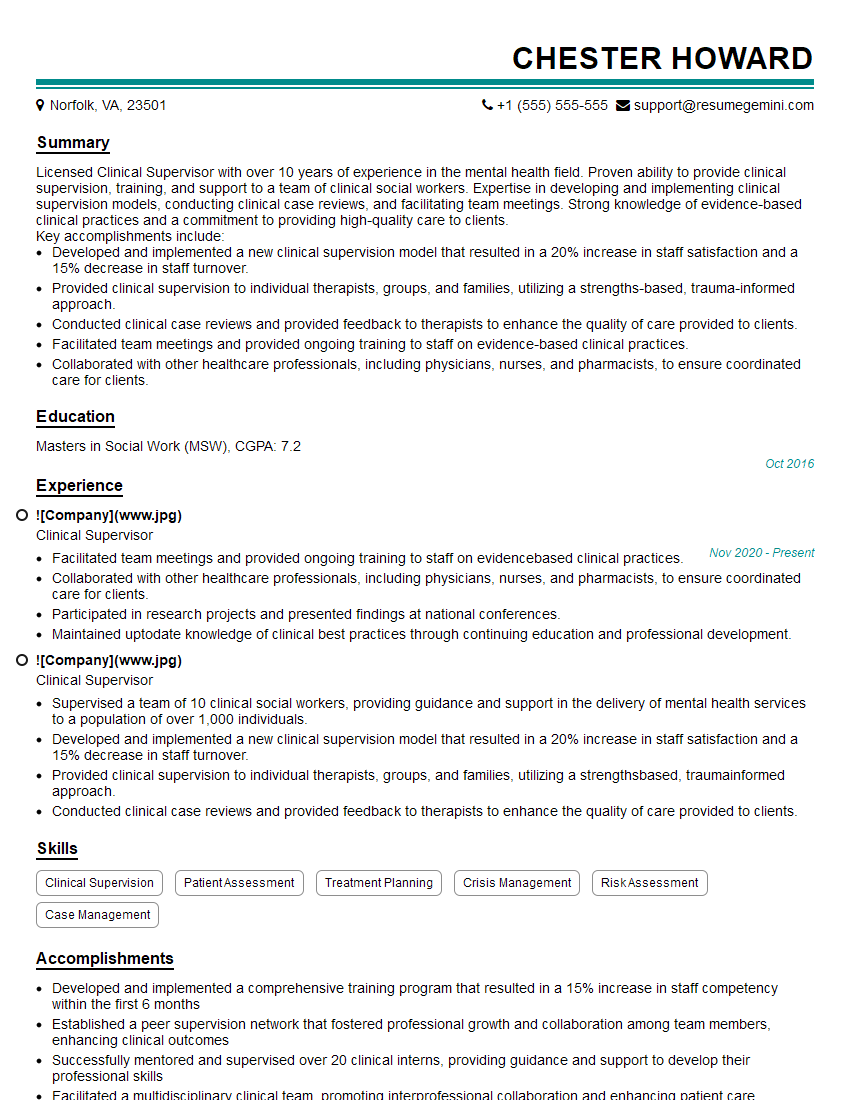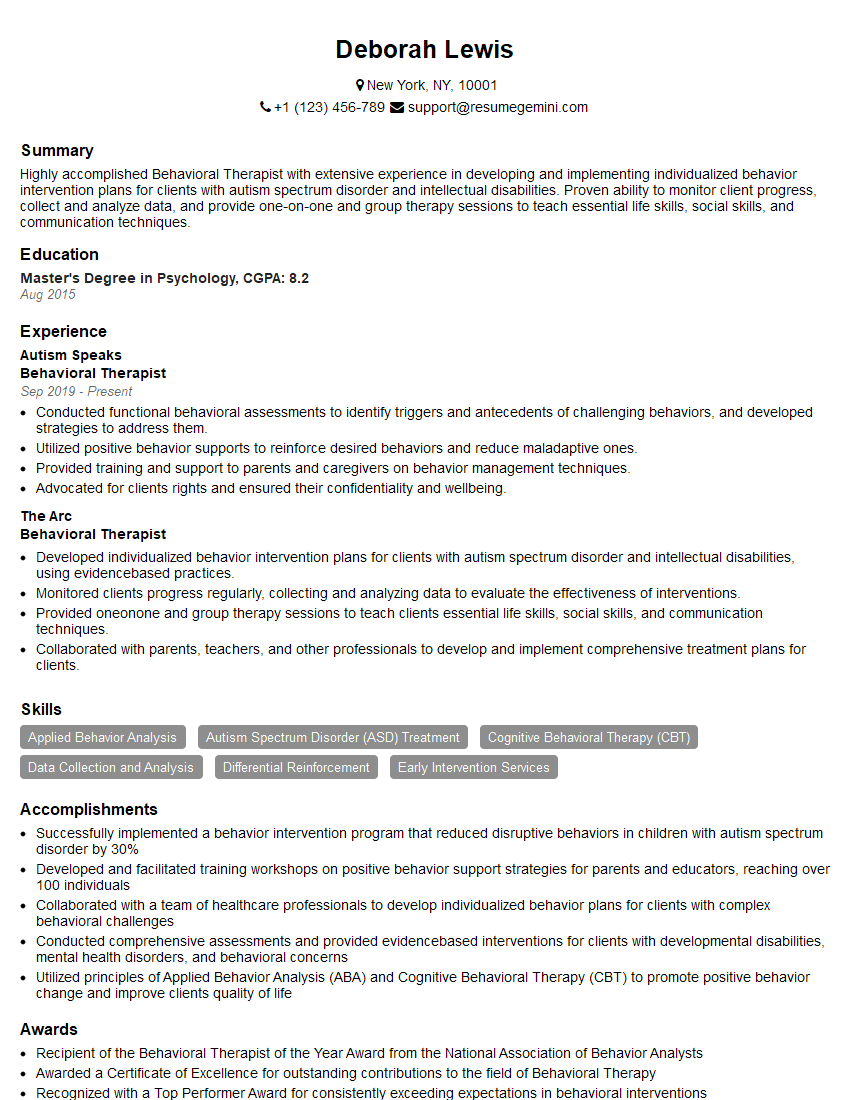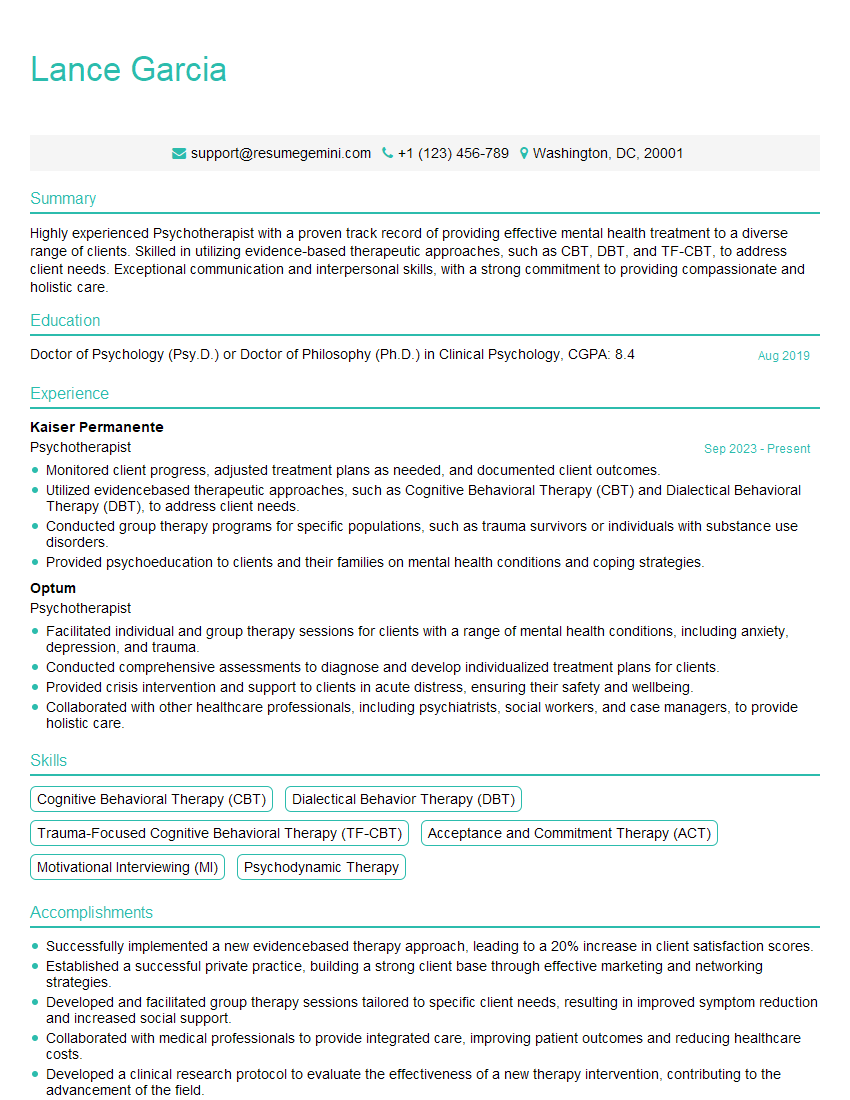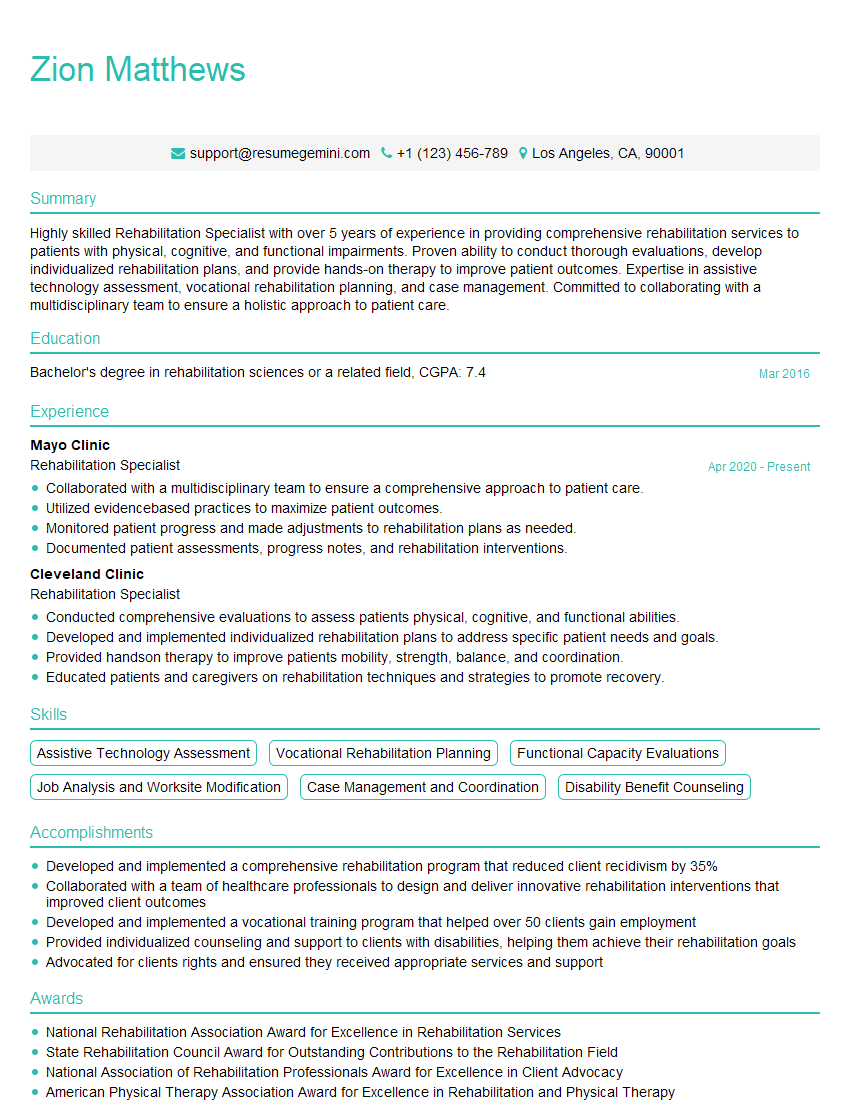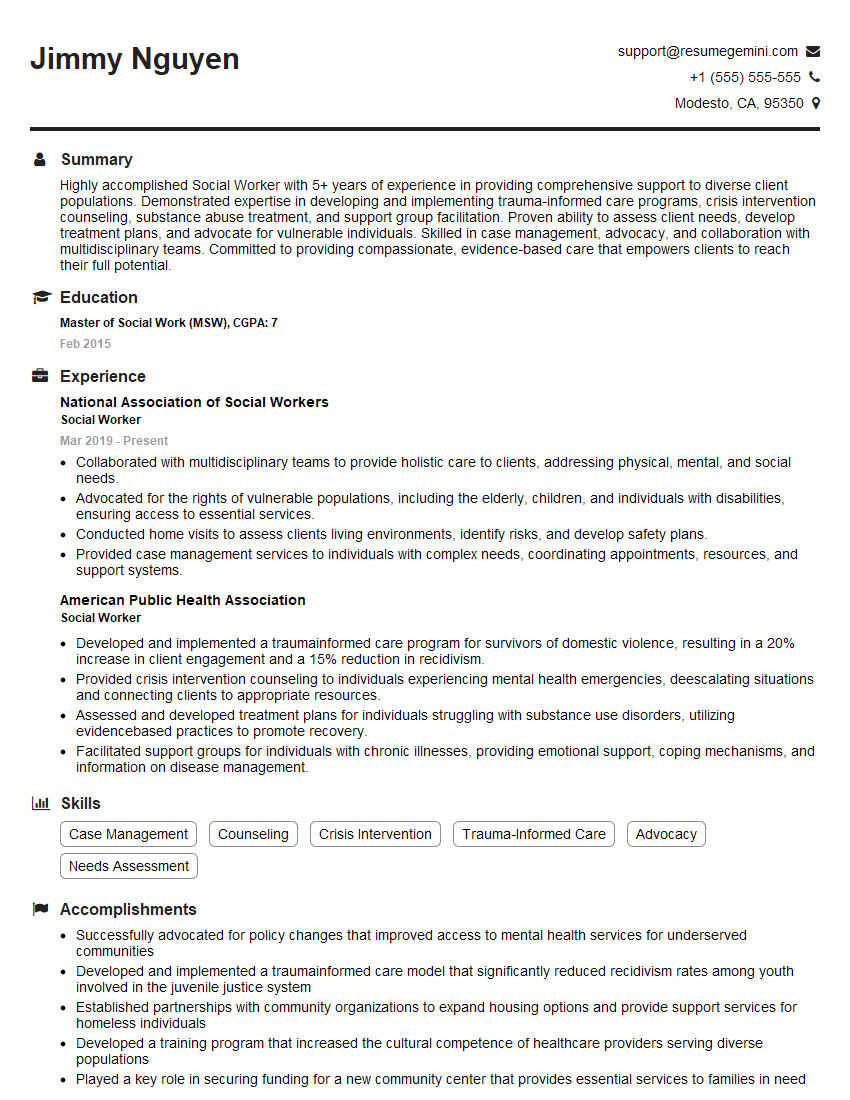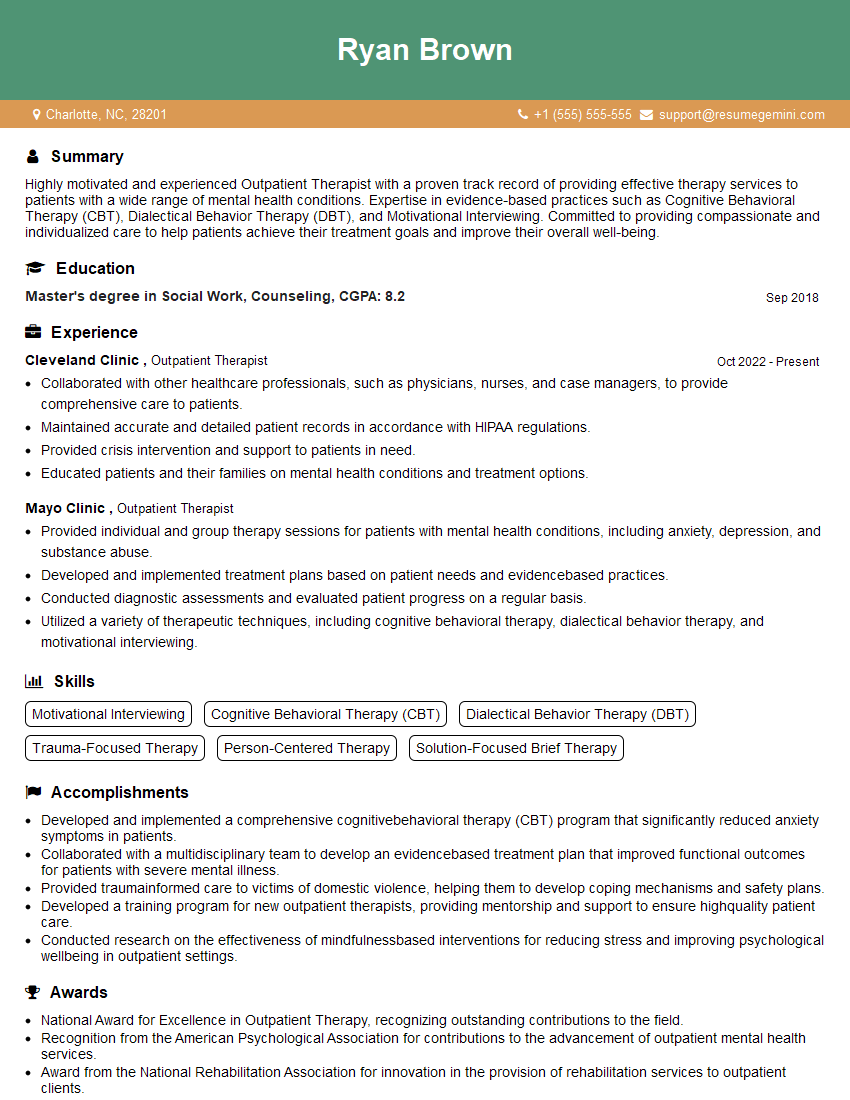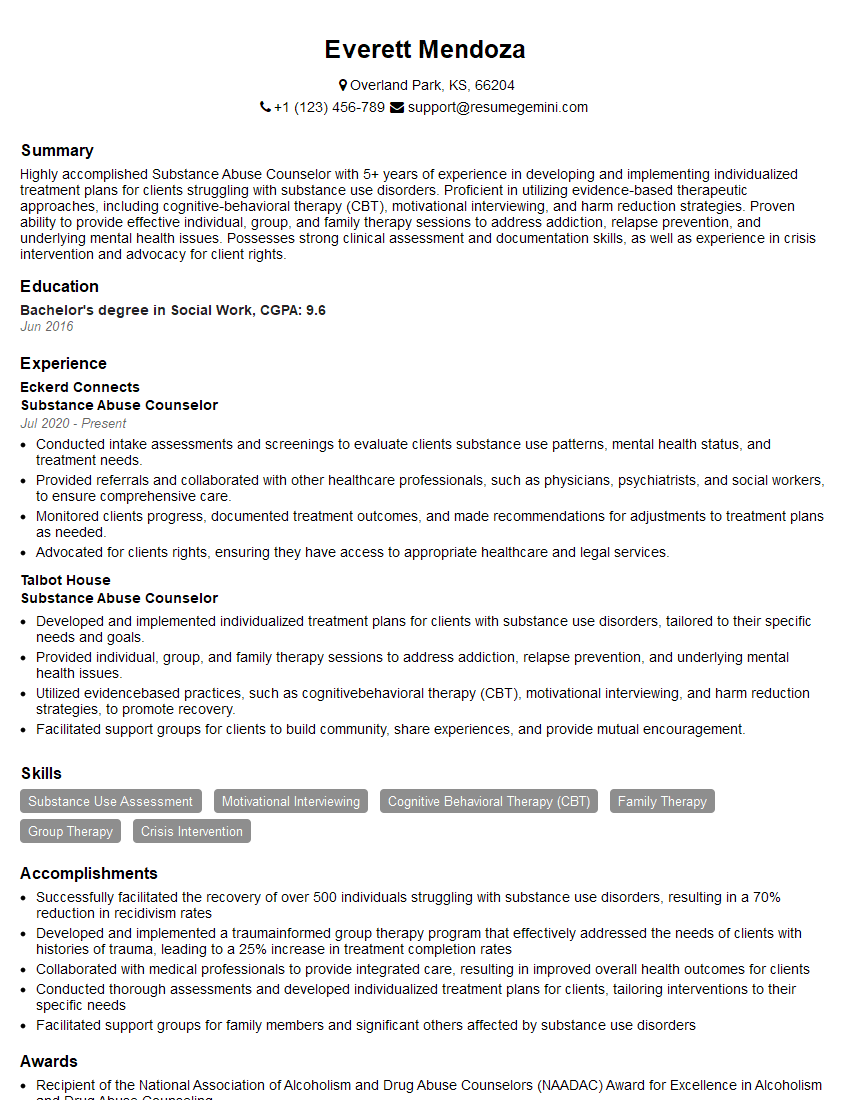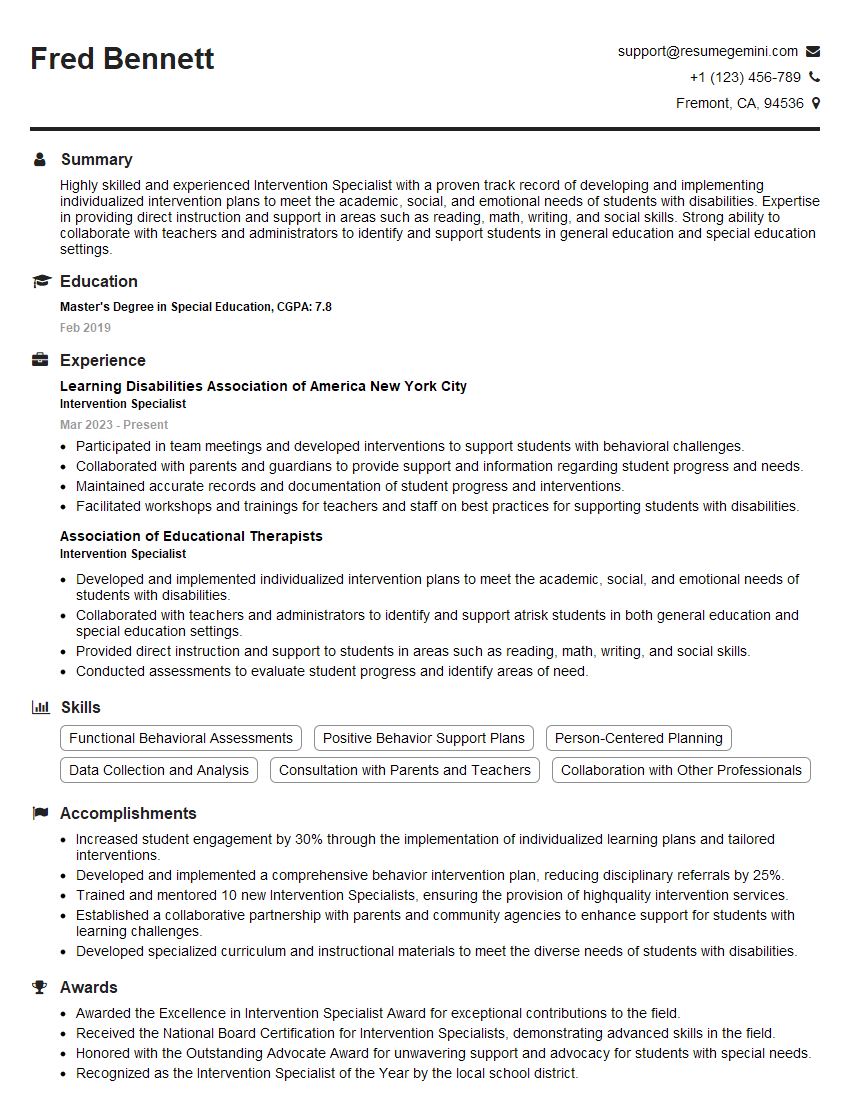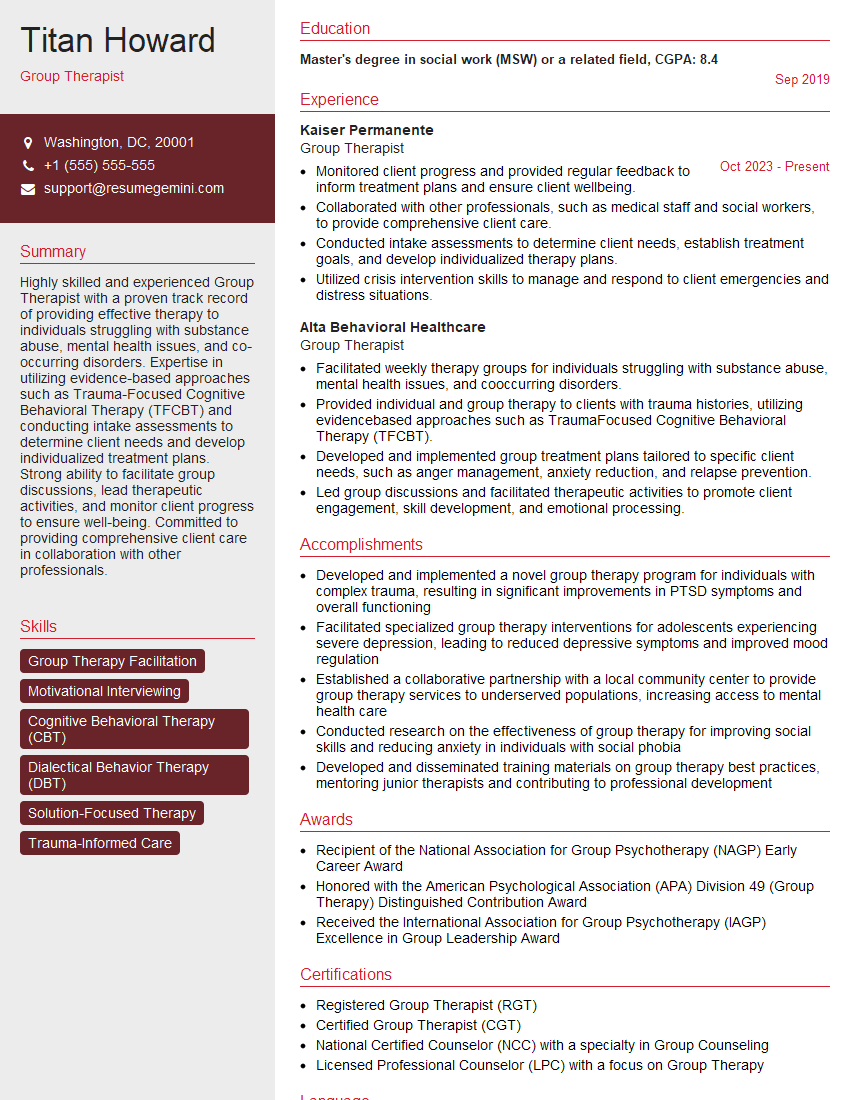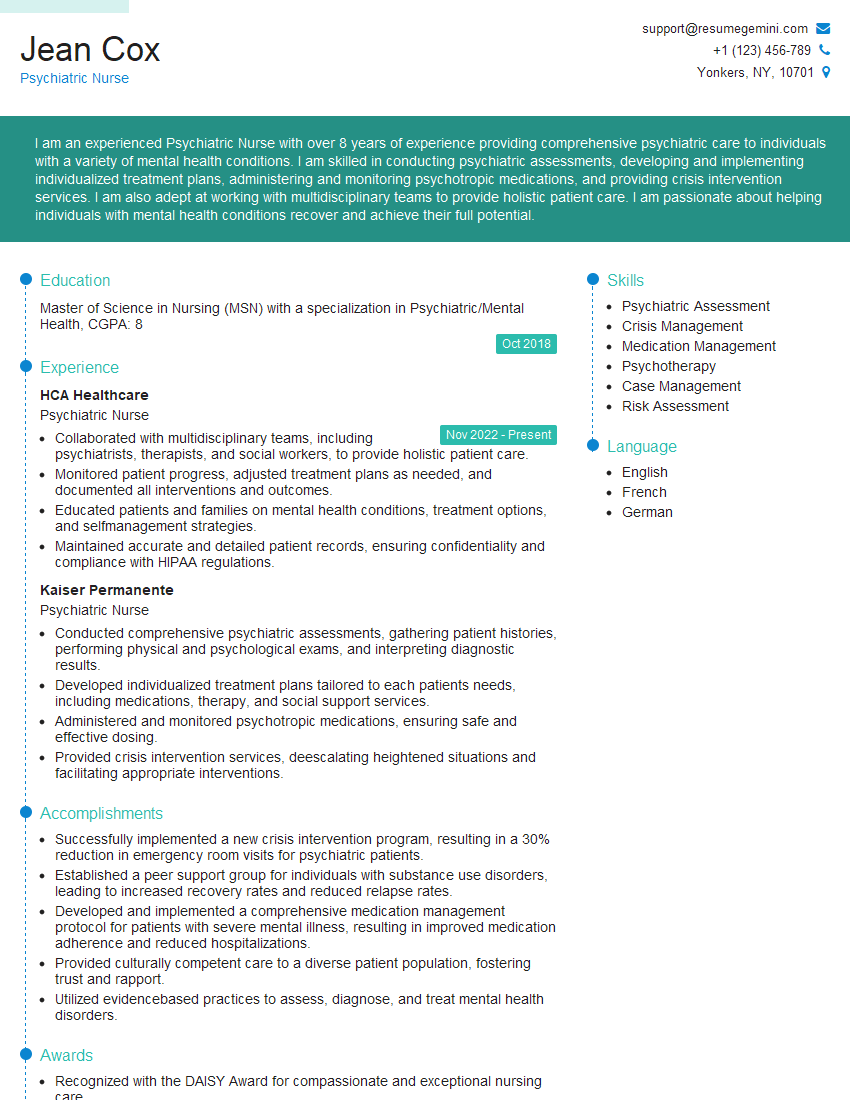Preparation is the key to success in any interview. In this post, we’ll explore crucial Relapse Prevention interview questions and equip you with strategies to craft impactful answers. Whether you’re a beginner or a pro, these tips will elevate your preparation.
Questions Asked in Relapse Prevention Interview
Q 1. Describe the stages of change model in the context of relapse prevention.
The Stages of Change model, also known as the Transtheoretical Model, is a crucial framework in relapse prevention. It outlines the process individuals go through as they modify their behavior. Understanding these stages helps tailor interventions to the client’s current level of readiness.
- Precontemplation: The individual isn’t considering change. They may be unaware of the problem or its impact. Example: A person with alcohol dependence doesn’t believe they have a problem.
- Contemplation: The individual is aware of the problem and is starting to consider change, but hasn’t yet committed. Example: The person acknowledges their drinking is excessive but isn’t ready to stop.
- Preparation: The individual is making plans for change, perhaps setting small goals or seeking resources. Example: They start researching treatment options or cut down their drinking slightly.
- Action: The individual is actively engaging in the chosen behavior change. Example: The person attends therapy sessions and actively avoids alcohol.
- Maintenance: The individual is working to maintain the changed behavior and prevent relapse. This stage can last indefinitely. Example: The person stays sober for months or years, attending support groups and practicing relapse prevention strategies.
- Relapse: A return to the previous behavior. This isn’t failure but a part of the process. Example: The person experiences a setback and drinks alcohol. The key is to learn from this and continue moving forward.
Relapse prevention strategies are tailored to each stage. For example, in the precontemplation stage, motivational interviewing techniques are employed, while in the maintenance stage, focus shifts towards building coping skills and identifying high-risk situations.
Q 2. Explain the importance of identifying high-risk situations in relapse prevention planning.
Identifying high-risk situations is paramount in relapse prevention because these situations significantly increase the likelihood of returning to the problematic behavior. By understanding and proactively planning for these situations, individuals can significantly reduce their risk of relapse.
For example, imagine a person recovering from opioid addiction. High-risk situations for them might include:
- Spending time with old friends who use opioids.
- Experiencing intense emotional distress (e.g., job loss, relationship problems).
- Being in locations previously associated with opioid use.
- Exposure to triggers such as stress or boredom.
By identifying these specific situations, a relapse prevention plan can be tailored to develop coping mechanisms and strategies for navigating each scenario. This might involve avoiding certain locations, establishing strong support systems, developing healthy coping skills for managing stress, and practicing mindfulness techniques to better handle triggers.
Q 3. What are some common cognitive distortions that contribute to relapse?
Cognitive distortions are inaccurate or unhelpful ways of thinking that often contribute to relapse. They create a distorted view of reality, leading to impulsive actions.
- All-or-nothing thinking: Viewing situations in extreme terms (e.g., “If I have one drink, I’ll be a failure.”).
- Overgeneralization: Drawing sweeping conclusions from a single event (e.g., “I had one drink, so I’m a lost cause.”).
- Mental filtering: Focusing only on negative aspects while ignoring positive ones (e.g., focusing only on setbacks and ignoring progress).
- Disqualifying the positive: Dismissing positive experiences as insignificant (e.g., “That positive feedback was just luck.”).
- Jumping to conclusions: Making assumptions without evidence (e.g., assuming others are judging or disapproving).
- Emotional reasoning: Believing that feelings reflect reality (e.g., “I feel overwhelmed, so I must use drugs.”).
- Should statements: Using rigid rules and expectations (e.g., “I should be perfect in recovery.”).
- Labeling: Assigning negative labels to oneself (e.g., “I’m a failure,” “I’m hopeless.”).
In relapse prevention, identifying and challenging these distortions is crucial. Cognitive Behavioral Therapy (CBT) techniques, such as cognitive restructuring, help individuals to reframe negative thoughts into more realistic and helpful ones.
Q 4. How would you teach a client to utilize coping mechanisms to manage cravings?
Teaching clients to use coping mechanisms for cravings is a cornerstone of relapse prevention. It involves equipping them with a range of strategies they can utilize in the moment when cravings arise. This is not about eliminating cravings, but managing them effectively.
My approach involves:
- Identifying triggers: We work together to pinpoint situations, emotions, or thoughts that precede cravings.
- Developing a coping skills menu: This menu lists various coping strategies categorized by their effectiveness. Some examples include:
- Distraction techniques: Engaging in activities like exercise, listening to music, or calling a friend.
- Relaxation techniques: Practicing deep breathing exercises, progressive muscle relaxation, or meditation.
- Problem-solving skills: Breaking down challenges into manageable steps and generating solutions.
- Self-soothing techniques: Engaging in pleasurable activities like taking a warm bath or reading a book.
- Seeking social support: Calling a support person or attending a support group.
- Role-playing and rehearsal: Practicing using coping skills in simulated high-risk situations helps build confidence and automaticity.
- Self-monitoring and evaluation: Keeping a journal to track cravings, triggers, and the effectiveness of coping strategies allows for adjustments to the plan.
For instance, if a client identifies stress as a trigger, we’d practice relaxation techniques and problem-solving strategies to handle stressful situations before they escalate to a craving.
Q 5. Discuss the role of family support in relapse prevention.
Family support plays a vital role in relapse prevention. A supportive family can provide encouragement, accountability, and practical assistance, significantly increasing the chances of successful recovery. Conversely, a dysfunctional or unsupportive family can greatly increase the risk of relapse.
Here’s how family involvement is crucial:
- Emotional support: Providing empathy, understanding, and encouragement.
- Practical support: Assisting with daily tasks, transportation, or childcare, easing burdens on the recovering individual.
- Accountability: Gently holding the individual accountable for their commitment to recovery.
- Education: Learning about the addiction, the recovery process, and relapse prevention strategies.
- Conflict resolution: Addressing conflicts constructively and fostering better communication within the family.
- Setting healthy boundaries: Establishing clear expectations for behavior and maintaining healthy relationships without enabling the addictive behavior.
Family therapy can be incredibly beneficial in addressing family dynamics, improving communication, and educating family members on the process of recovery and relapse prevention. It’s important to involve the family in a way that is respectful and empowering to the recovering individual.
Q 6. What are some evidence-based relapse prevention therapies?
Several evidence-based therapies are highly effective in relapse prevention. These are often integrated to provide a comprehensive approach.
- Cognitive Behavioral Therapy (CBT): Helps identify and modify negative thought patterns and behaviors that contribute to relapse.
- Motivational Interviewing (MI): Encourages self-motivation and commitment to change through collaborative conversation.
- Dialectical Behavior Therapy (DBT): Teaches skills for managing intense emotions, improving interpersonal relationships, and tolerating distress.
- Acceptance and Commitment Therapy (ACT): Focuses on accepting difficult emotions and committing to valued actions despite discomfort.
- Relapse Prevention Therapy (RPT): A specific type of therapy focused on identifying high-risk situations, developing coping skills, and creating a relapse prevention plan.
The choice of therapy depends on the individual’s specific needs and preferences. Often, a combination of therapies proves most effective. For example, CBT may be used to address cognitive distortions, while MI helps bolster motivation for change. DBT can add skills for emotional regulation, contributing to a strong relapse prevention strategy.
Q 7. How do you assess a client’s readiness for change?
Assessing a client’s readiness for change is crucial for tailoring effective interventions. It’s not a one-time assessment but an ongoing process throughout the treatment journey.
I use a multi-faceted approach that includes:
- Motivational interviewing techniques: Exploring the client’s ambivalence towards change, identifying their strengths and reasons for wanting to change.
- Self-report measures: Utilizing standardized questionnaires (like the Readiness to Change Questionnaire) to assess their stage of change and commitment to recovery.
- Clinical observation: Observing the client’s behavior, engagement level, and commitment to treatment sessions.
- Discussion of past attempts at change: Understanding past experiences with change can highlight patterns and potential obstacles.
- Assessment of support systems: Evaluating the availability and strength of social support networks.
By gathering information from multiple sources, I obtain a comprehensive understanding of the client’s readiness. This allows for a personalized treatment plan that matches their level of motivation and addresses their individual needs. For instance, a client in the precontemplation stage would require different interventions than a client in the action stage.
Q 8. Explain the concept of ‘lapse’ versus ‘relapse’.
The terms ‘lapse’ and ‘relapse’ are often confused, but represent distinct stages in the recovery process. A lapse is a single instance of engaging in the problematic behavior after a period of abstinence. Think of it as a slip-up, a momentary lapse in judgment. For example, someone recovering from alcohol addiction might have one drink at a party. A relapse, on the other hand, is a return to the previous pattern of problematic behavior. It’s a significant shift, not just a single incident. Continuing to drink after that initial drink, eventually returning to daily heavy drinking, would constitute a relapse. The key difference lies in the duration and intensity of the behavior. A lapse is a temporary setback, while a relapse represents a more significant setback requiring intervention.
Understanding this distinction is crucial because it influences how we approach support and intervention. A lapse is an opportunity for learning and readjustment; a relapse often requires more intensive intervention.
Q 9. Describe your approach to motivational interviewing in the context of relapse prevention.
Motivational interviewing (MI) is a cornerstone of my relapse prevention approach. It’s a client-centered, directive method for enhancing intrinsic motivation to change. In relapse prevention, MI helps clients explore their ambivalence about change, identify their own reasons for wanting to remain abstinent, and develop their own strategies for coping with cravings and high-risk situations. I don’t tell clients what to do; instead, I guide them through a process of self-discovery and commitment.
For example, if a client is struggling with gambling addiction, I might use open-ended questions like, “Tell me about your experiences with gambling lately,” or “What are some of the benefits and drawbacks of continuing to gamble?” Through reflective listening and summarizing, I help the client clarify their values and goals, and collaboratively develop a plan that aligns with their own aspirations.
I use MI techniques such as rolling with resistance (acknowledging the client’s hesitation without directly opposing it) and developing discrepancy (helping the client see the conflict between their current behavior and their values) to facilitate change talk and empower the client to take ownership of their recovery.
Q 10. How would you address a client experiencing a relapse?
A relapse is not a failure; it’s an opportunity for learning and readjustment. My approach focuses on understanding the circumstances that led to the relapse, without judgment or blame. First, I would create a safe and non-judgmental space for the client to discuss their experience openly. We would collaboratively examine what triggered the relapse: was it stress, a social situation, a change in routine, or an unmet need?
Next, we would review the relapse prevention plan, identifying areas that need strengthening. Perhaps the plan didn’t adequately address specific triggers, or the coping mechanisms weren’t robust enough. We might revise the plan to include more effective strategies, such as strengthening support systems, adjusting medication if necessary, or incorporating new coping skills like mindfulness or stress management techniques.
Finally, I would help the client to re-engage with their recovery goals and re-establish their commitment to abstinence. This might involve adjusting their environment, strengthening their support network, or exploring additional therapeutic interventions.
Q 11. What are the ethical considerations when working with clients prone to relapse?
Ethical considerations are paramount when working with clients prone to relapse. Confidentiality is crucial; I ensure clients understand the limits of confidentiality and any potential mandatory reporting obligations. Informed consent is essential; clients need to fully understand the treatment process, including its potential risks and benefits. I must maintain professional boundaries, ensuring a therapeutic relationship free from dual relationships or conflicts of interest.
Another important consideration is self-care. Working with individuals facing relapse can be emotionally demanding, and it is crucial for me to maintain my own well-being through supervision, consultation, and self-reflection to prevent burnout and maintain ethical practice.
Furthermore, I must be sensitive to the client’s autonomy. While I offer guidance and support, the ultimate decisions regarding treatment and recovery rest with the client. I must respect their choices, even if those choices differ from my recommendations.
Q 12. How do you tailor a relapse prevention plan to individual needs?
Tailoring a relapse prevention plan requires a thorough assessment of the individual’s unique circumstances. This includes their specific addiction (substance use, gambling, eating disorders, etc.), their personal history, their social support system, their coping mechanisms, and their triggers. I use a collaborative approach, working closely with the client to understand their strengths, weaknesses, and preferences.
For example, a plan for someone with substance use disorder might emphasize medication-assisted treatment, 12-step programs, and individual therapy. In contrast, a plan for someone with a gambling addiction might focus on cognitive-behavioral therapy (CBT), financial management strategies, and harm reduction techniques. The plan is always individualized, flexible, and adaptable, allowing for adjustments based on the client’s progress and changing needs.
Q 13. What are the key components of a comprehensive relapse prevention plan?
A comprehensive relapse prevention plan typically includes several key components:
- Identification of high-risk situations: Pinpointing situations, people, places, or thoughts that trigger cravings or increase the risk of relapse.
- Development of coping skills: Learning strategies to manage cravings, stress, and difficult emotions, such as relaxation techniques, problem-solving skills, and assertive communication.
- Enhancement of social support: Building a strong support network of family, friends, or support groups to provide encouragement and accountability.
- Lifestyle adjustments: Making necessary changes to lifestyle that support recovery, such as improving sleep hygiene, nutrition, and physical activity.
- Relapse prevention planning: Creating a concrete plan that outlines steps to take if a lapse or relapse occurs, including identifying potential warning signs and developing strategies for early intervention.
- Regular monitoring and evaluation: Regularly reviewing the plan, assessing progress, and making adjustments as needed. This often involves regular therapy sessions and ongoing support.
This approach ensures the plan addresses the client’s individual needs and provides a structured framework for maintaining long-term recovery.
Q 14. Describe your experience with different types of addiction (e.g., substance use, gambling, etc.)
My experience encompasses various types of addiction, including substance use disorders (alcohol, opioids, stimulants), gambling addiction, eating disorders, and sex addiction. While the specific behaviors and underlying mechanisms vary across these addictions, the core principles of relapse prevention remain consistent. The focus is always on understanding the individual’s unique experience, identifying their triggers, developing coping mechanisms, and building a strong support system. Each addiction presents its own set of challenges and requires tailored interventions. For example, the treatment for opioid addiction may involve medication-assisted treatment, while treatment for gambling addiction often emphasizes cognitive-behavioral therapy to address underlying thought patterns and impulsive behaviors. My approach is adaptable and flexible to accommodate the specific nuances of each client’s struggle.
Q 15. How do you handle resistance from a client during relapse prevention sessions?
Resistance during relapse prevention is common. It often stems from fear, shame, or a lack of trust. My approach focuses on understanding the root of the resistance, not confronting it directly. I start by validating their feelings. For example, I might say, “I understand that this process can be difficult and that you might feel hesitant to explore certain areas.” Then, I collaboratively explore their concerns. This might involve asking open-ended questions like, “What are your biggest concerns about participating in this program?” or “What makes you feel resistant right now?” Once we’ve identified the source of their resistance, we work together to find strategies to address it. This might involve adjusting the treatment plan, focusing on achievable goals, or exploring alternative coping mechanisms. The key is to build a strong therapeutic alliance based on empathy and mutual respect. Remember, progress is not always linear, and setbacks are opportunities for learning and growth. For example, If a client resists discussing high-risk situations, instead of pushing, I might focus on building their confidence in other areas of their recovery, making them more receptive to exploring those high-risk situations later.
Career Expert Tips:
- Ace those interviews! Prepare effectively by reviewing the Top 50 Most Common Interview Questions on ResumeGemini.
- Navigate your job search with confidence! Explore a wide range of Career Tips on ResumeGemini. Learn about common challenges and recommendations to overcome them.
- Craft the perfect resume! Master the Art of Resume Writing with ResumeGemini’s guide. Showcase your unique qualifications and achievements effectively.
- Don’t miss out on holiday savings! Build your dream resume with ResumeGemini’s ATS optimized templates.
Q 16. Explain the importance of self-monitoring in relapse prevention.
Self-monitoring is crucial in relapse prevention because it provides valuable insights into personal triggers, coping mechanisms, and patterns of behavior. It’s like having a personal GPS for your recovery journey. By tracking thoughts, feelings, behaviors, and situations, clients gain a deeper understanding of their own vulnerabilities. This understanding enables them to anticipate potential problems and develop proactive strategies to avoid them. For instance, if a client notices that they tend to relapse when stressed, they can develop a plan to manage stress proactively, such as engaging in relaxation techniques or reaching out to their support network. This data-driven approach replaces guesswork with evidence-based decision-making. Common self-monitoring tools include daily journals, mood trackers, and smartphone apps. The information gleaned from these tools is then used in therapy sessions to collaboratively refine the relapse prevention plan and ensure that it remains relevant and effective.
Q 17. How do you integrate medication management into a relapse prevention plan?
Medication management is a critical component for many individuals in relapse prevention, especially those with co-occurring disorders. It’s not simply about taking prescribed medication; it’s about a collaborative approach that involves education, adherence strategies, and monitoring for side effects. I work closely with the client’s psychiatrist or prescribing physician to ensure seamless coordination of care. This includes regular communication to track progress, adjust medication dosages if needed, and address any concerns. In sessions, I discuss potential side effects, emphasizing the importance of reporting them promptly. I also help clients develop strategies for medication adherence, such as setting reminders, using pill organizers, and involving a trusted support person. For clients who struggle with adherence, we explore the underlying reasons for their difficulties, addressing any related concerns or misconceptions. Remember, medication is only one part of the comprehensive relapse prevention plan, and its effectiveness depends on the client’s overall engagement in the treatment process.
Q 18. Discuss the role of relapse prevention in long-term recovery.
Relapse prevention isn’t just about avoiding a single setback; it’s about building a sustainable foundation for long-term recovery. It equips individuals with the skills and strategies needed to navigate challenges and maintain their sobriety or abstinence over time. It’s a continuous process, not a one-time fix. The skills learned—such as coping mechanisms, identifying triggers, and building a support network—become invaluable throughout life’s ups and downs. A relapse prevention plan isn’t static; it evolves as a person’s life changes. This ongoing process makes it easier to manage stressors and triggers that can lead to relapse as the individual progress through their recovery journey. By consistently practicing these skills and regularly reviewing their relapse prevention plan with their therapist, individuals can build resilience and significantly reduce the risk of long-term relapse.
Q 19. What are some common barriers to successful relapse prevention?
Several barriers can hinder successful relapse prevention. One common barrier is a lack of motivation or commitment. Some individuals might not fully grasp the importance of relapse prevention, while others may be overwhelmed by the demands of the program. Another significant barrier is a lack of strong social support. Isolation and a lack of connection with supportive individuals can significantly increase vulnerability to relapse. Stressful life events, such as job loss, relationship difficulties, or financial problems, can also trigger relapse, as can untreated co-occurring disorders, such as anxiety or depression. Finally, unrealistic expectations or a lack of self-compassion can undermine progress, as setbacks are common parts of the recovery journey. Addressing these barriers requires a holistic approach involving education, skill-building, support system development, and stress management techniques.
Q 20. How do you build rapport and trust with clients who are struggling with relapse?
Building rapport and trust with clients struggling with relapse is paramount. It requires empathy, patience, and a genuine desire to understand their experiences. I begin by actively listening to their stories without judgment. I make an effort to understand the context of their relapse, recognizing that it’s often a complex interaction of factors rather than a simple failure of willpower. I validate their feelings, acknowledging the pain and frustration they may be experiencing. I emphasize that relapse is a common experience and doesn’t negate their progress. I strive to create a safe and non-judgmental space where they feel comfortable sharing their vulnerabilities without fear of criticism or rejection. By demonstrating genuine care and consistently demonstrating reliability, I aim to build a collaborative partnership focused on recovery rather than blame.
Q 21. What are some strategies for relapse prevention in different settings (e.g., inpatient, outpatient)?
Relapse prevention strategies vary across settings. In inpatient settings, the focus is on intensive stabilization and skill-building. This might involve daily group and individual therapy sessions, medication management, and participation in structured activities. The structured environment provides support and reduces access to potential triggers. In outpatient settings, the emphasis shifts towards building self-sufficiency and relapse prevention skills. This involves individual and group therapy, ongoing medication management, and development of a personalized relapse prevention plan that the client can independently implement. Community-based support groups and ongoing case management are crucial components of outpatient relapse prevention. Ultimately, the goal is to transition the client from a highly structured environment to managing their recovery independently. Throughout both settings, a consistent, collaborative approach centered on the client’s unique needs and strengths is key to building a resilient foundation for recovery.
Q 22. Explain the difference between relapse prevention and harm reduction strategies.
Relapse prevention and harm reduction are distinct but complementary approaches in addiction treatment. Relapse prevention focuses on identifying and modifying high-risk situations and behaviors that could lead to a return to substance use or undesirable behaviors. The goal is to prevent relapse altogether. Harm reduction, on the other hand, aims to minimize the negative consequences associated with substance use or other risky behaviors, even if complete abstinence isn’t immediately achieved. Think of it this way: relapse prevention is like building a strong fence around your property to keep out intruders, while harm reduction is like installing smoke detectors and fire extinguishers inside to minimize damage if an intruder does get in.
For example, a relapse prevention plan might involve identifying triggers (e.g., stressful situations, social gatherings) and developing coping mechanisms (e.g., relaxation techniques, assertive communication). A harm reduction strategy, in contrast, might involve providing access to naloxone to reverse opioid overdoses or promoting safer injection practices among individuals who continue to use drugs.
Q 23. Describe your experience using different assessment tools related to relapse risk.
I have extensive experience utilizing various assessment tools to gauge relapse risk. These include structured interviews like the Substance Abuse Subtle Screening Inventory (SASSI) and the Addiction Severity Index (ASI), which provide a comprehensive picture of the client’s substance use history, current functioning, and psychosocial factors. I also use self-report questionnaires like the Brief MAST (Michigan Alcohol Screening Test) or the DAST (Drug Abuse Screening Test) for quicker assessments. Further, I employ scales to evaluate specific aspects like craving intensity (e.g., the Visual Analogue Scale for Craving), or mood disorders (e.g., PHQ-9 for depression). The choice of assessment tool depends on the client’s specific needs and the clinical context.
For instance, with a client struggling with alcohol dependence, I might use the ASI to comprehensively assess their substance use history and social functioning, supplementing this with the Brief MAST for a quick, initial screening of alcohol use problems. The data from these assessments informs the development of a tailored relapse prevention plan.
Q 24. How do you measure the effectiveness of your relapse prevention interventions?
Measuring the effectiveness of relapse prevention interventions is crucial. I use a multi-faceted approach, combining quantitative and qualitative data. Quantitative measures often involve tracking abstinence rates (duration of sobriety), frequency of substance use (if relapse occurs), and participation in treatment sessions. For instance, I might monitor a client’s urine toxicology reports to confirm abstinence, or track their attendance at therapy sessions. Qualitative data, obtained through regular client interviews and feedback, helps understand the client’s subjective experience, challenges faced, and progress in implementing relapse prevention strategies.
Beyond abstinence, other measures include improvements in psychological well-being (measured through self-report measures or clinical observations), enhanced social functioning, and reduced engagement in high-risk behaviors. A strong focus is placed on the client’s self-reported progress and their perceived level of preparedness to manage high-risk situations.
Q 25. How do you maintain professional boundaries while working with clients who are vulnerable to relapse?
Maintaining professional boundaries is paramount when working with vulnerable clients. This involves adhering to ethical guidelines set by professional organizations. Key aspects include clearly defining the therapeutic relationship, avoiding dual relationships (e.g., becoming friends or engaging in business dealings), and respecting client confidentiality. I ensure all interactions remain within the therapeutic context, focusing solely on the client’s treatment goals. Regular supervision helps me reflect on my practice and identify potential boundary issues.
For example, I might avoid accepting gifts from clients, maintaining a professional distance that ensures the client feels safe and understood without blurring the boundaries of our professional relationship. This careful approach fosters trust and empowers the client to focus on their recovery.
Q 26. How would you address a situation where a client’s relapse prevention plan needs adjustment?
Adjusting a relapse prevention plan is a collaborative process. If a client experiences a setback, or if the initial plan isn’t proving effective, I work closely with the client to identify the reasons. This involves reviewing the plan’s components, such as triggers, coping mechanisms, and support systems. We explore whether the identified triggers are still relevant, if the coping mechanisms are adequate, or if the client needs additional support. The adjusted plan might involve strengthening existing strategies, adding new ones, or modifying the treatment approach itself.
For instance, if a client relapses because of social pressure, we might add strategies for assertive communication or explore alternative social support networks. The process is iterative, and regular evaluation ensures the plan continues to meet the client’s evolving needs.
Q 27. How do you incorporate cultural sensitivity into your approach to relapse prevention?
Cultural sensitivity is fundamental to effective relapse prevention. I acknowledge that cultural backgrounds profoundly influence individuals’ experiences, beliefs, and coping mechanisms. I avoid making assumptions and instead actively seek to understand the client’s unique cultural context, including their values, beliefs, family structures, and social support networks. This involves asking thoughtful questions and using culturally appropriate communication techniques. I also strive to collaborate with community resources that are culturally relevant and accessible to the client.
For example, when working with a client from a specific cultural background, I would research their cultural beliefs and practices related to substance use and recovery. This allows me to tailor the interventions to be culturally sensitive and to avoid potential misunderstandings or biases that could hinder the treatment process.
Q 28. Describe your experience working within a multidisciplinary team for addiction treatment.
My experience working within multidisciplinary teams has been invaluable. In addiction treatment, a collaborative approach is vital, involving psychiatrists, psychologists, social workers, nurses, and case managers. Each professional contributes their expertise, leading to more comprehensive and holistic care. I regularly participate in team meetings, contributing to treatment planning, sharing assessments, and coordinating care with other team members. This collaborative environment allows for consistent communication, efficient resource allocation, and a shared understanding of the client’s needs.
For example, in a recent case, I worked with a psychiatrist to manage a client’s medication, a social worker to address housing instability, and a case manager to coordinate access to community resources. This team-based approach allowed for addressing the multiple facets of the client’s challenges and greatly increased the effectiveness of the intervention.
Key Topics to Learn for Relapse Prevention Interview
- The Relapse Prevention Model: Understand the core components of Marlatt & Gordon’s model, including high-risk situations, coping skills, and the abstinence violation effect.
- Cognitive Behavioral Therapy (CBT) Techniques: Familiarize yourself with CBT’s role in relapse prevention, including cognitive restructuring, behavioral experiments, and problem-solving strategies. Be prepared to discuss practical applications in various settings.
- Motivational Interviewing (MI): Demonstrate understanding of MI principles and how to apply them to enhance client motivation and commitment to change. Discuss the importance of collaboration and empathy.
- Assessment and Treatment Planning: Explain the process of conducting thorough assessments to identify risk factors, strengths, and triggers. Be able to articulate how this information informs individualized treatment plans.
- High-Risk Situations and Coping Strategies: Discuss common high-risk situations that can lead to relapse and practical strategies for coping, such as stress management, self-monitoring, and social support.
- The Abstinence Violation Effect (AVE): Explain the AVE and its implications for treatment. Discuss techniques to mitigate the negative impact of lapses and prevent full-blown relapse.
- Relapse Prevention in Specific Populations: Be prepared to discuss adaptations of relapse prevention strategies for different populations (e.g., substance use disorders, eating disorders, gambling addiction).
- Ethical Considerations: Understand the ethical implications of relapse prevention, including client autonomy, confidentiality, and informed consent.
- Measuring Treatment Outcomes: Discuss various methods for assessing treatment effectiveness and measuring client progress in relapse prevention.
Next Steps
Mastering relapse prevention techniques is crucial for a successful career in behavioral health and related fields. It demonstrates a deep understanding of evidence-based practices and your commitment to client well-being. To significantly boost your job prospects, it’s vital to present your skills effectively through an ATS-friendly resume. ResumeGemini is a trusted resource to help you craft a professional and impactful resume that highlights your expertise in relapse prevention. Examples of resumes tailored to this field are available to help you create a winning application.
Explore more articles
Users Rating of Our Blogs
Share Your Experience
We value your feedback! Please rate our content and share your thoughts (optional).
What Readers Say About Our Blog
Interesting Article, I liked the depth of knowledge you’ve shared.
Helpful, thanks for sharing.
Hi, I represent a social media marketing agency and liked your blog
Hi, I represent an SEO company that specialises in getting you AI citations and higher rankings on Google. I’d like to offer you a 100% free SEO audit for your website. Would you be interested?
